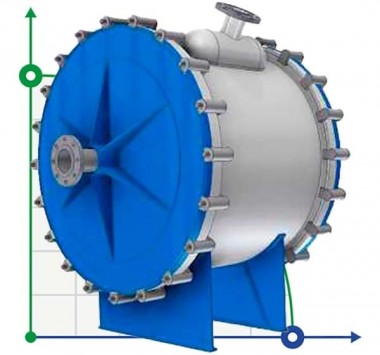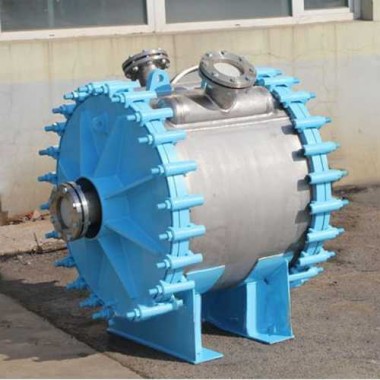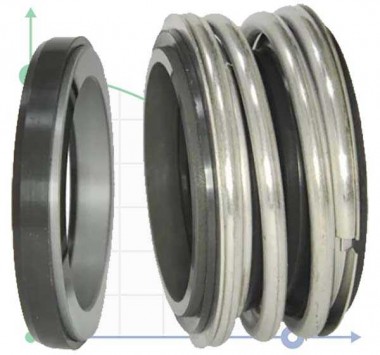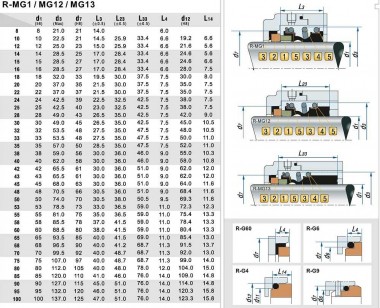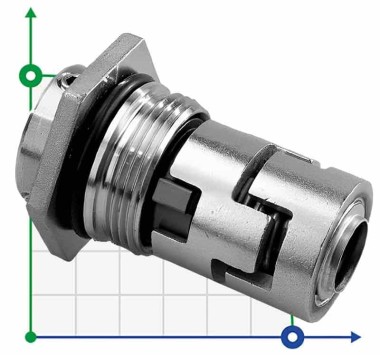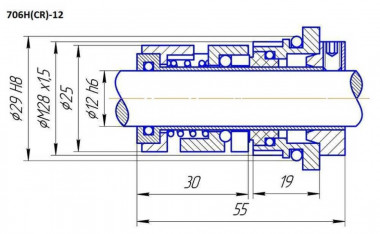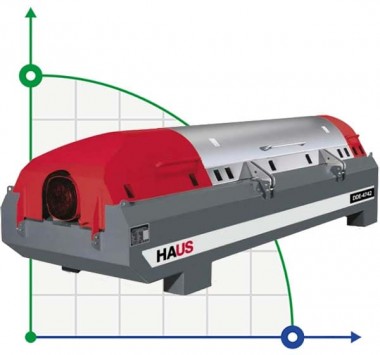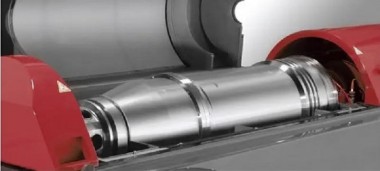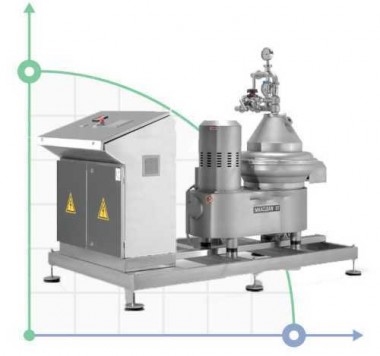Shaft seal for screws, mixers, conveyors, mixers, reactors
The shaft seal is suitable for ensuring the tightness of the agitator shaft in the production of concentrates, dairy products, evaporators, fermenters, devices in the production of juices, concentrates, confectionery industry, herbal extracts and the production of cosmetic products, creams, care products, etc.
They are also widely used for the reconstruction of screw conveyors of bulk products: sugar, cement, wet products for drying complexes, feeding and mixing in feeders and feeding systems, where it is necessary to obtain a shaft seal with beating.
For installations for dewatering activated sludge, housing and communal services, waste disposal plants and more.
It can be carried out according to a special assignment from different materials depending on the operating conditions and application.
Dimensions (edit)
PALM 30, 40, 50, 60

PALM 70, 80, 90, 100

Dimensions in AISI version (stainless steel)
| Model | d1 **, mm | d2, mm | D, mm | J, mm | N, mm | h, mm | Weight, kg | Permissible radial runout, mm |
| PALM 30 | thirty | 93,7 | 160 | 82.5 | 11.5 | 48 | 3.7 | five |
| PALM 40 | 40 | 115.9 | 170 | 101.5 | 14.5 | 52 | 5.9 | five |
| PALM 50 | fifty | 125.4 | 190 | 111 | 14.5 | 66 | 9.4 | 6 |
| PALM 60 | 60 | 161.9 | 220 | 143 | eighteen | 77 | 12.8 | 6 |
| PALM 70 | 70 | ** | 250 | 152 | 19 | 86 | 11.4 | 7 |
| PALM 80 | 80 | ** | 274 | 165 | 23 | 86 | 13.7 | 7 |
| PALM 90 | 90 | ** | 310 | 187 | 23 | 96 | eighteen | 7 |
| PALM 100 | one hundred | ** | 330 | 210 | 27 | 96 | 20.4 | 8 |
* - for each standard size (model), it is possible to select the diameter of the sealed shaft in the range from +2 to -7 mm without changes in the size of the case
** - centering shoulder on request

Dimensions AL (aluminum)
| Model | d1, mm | A, mm | J, mm | N, mm | h, mm | Weight, kg | Permissible radial runout, mm |
| PALM 30 | thirty | 124 | 82.5 | 11.5 | 48 | 1.3 | five |
| PALM 40 | 40 | 146 | 101.5 | 14.5 | 52 | 1.8 | five |
| PALM 50 | fifty | 160 | 111 | 14.5 | 62 | 2.5 | 6 |
| PALM 60 | 60 | 186 | 143 | eighteen | 62 | 3.5 | 6 |
| PALM 70 | 70 | 205 | 152 | 19 | 75 | 4.9 | 7 |
| PALM 80 | 80 | 220 | 165 | 23 | 86 | 6.4 | 7 |
| PALM 90 | 90 | 250 | 187 | 23 | 86 | 8.3 | 7 |
| PALM 100 | one hundred | 270 | 210 | 27 | 96 | 11.5 | 8 |
Purpose of the product
Seals of this type are designed to seal the shafts of equipment of various types such as agitators, screw and screw conveyors, dough mixers, chemical reactors, inclined screw conveyors, belt blenders, paddle mixers and dryers.
Seals are used when transporting dry powders, emulsions and suspensions to food, pharmaceutical and chemical industries where minimum maintenance costs.
This type of seal is an alternative to lip seals and classic stuffing box packing. The PALM seal is free from the disadvantages of both of the above types seals, namely, increased requirements for the cleanliness of shaft processing at the seal point, radial runout or shaft misalignment tolerances, frequent maintenance, product leakage.
Device
The PALM is a dynamic sealing assembly. An elastomeric sleeve is placed in the stationary body, compressed by fluoroplastic discs. The sleeve rotates with the shaft in the seal housing, being in a permanent face contact with the sealing discs in the housing.
Between the body of the seal itself and the wall of the container (hopper), a sealing rubber O-ring that prevents product leakage through the gaps between the seal and container body.
Thus, in the seal, the primary sealing of the shaft is carried out in three possible directions - shaft leakage, leakage between seal housing and housing containers, product leakage between the sealing discs of the seal itself.
The dynamic action of the seal, namely the second stage of sealing, is based on the principle of purging (backing up) the sealing chamber with compressed air.
The seal housing has a compressed air connection. Excessive pressure in the inner cavity of the seal guarantees its normal operation and no product leakage, even with significant wear on the sealing discs. Pressure the air supplied to the seal should exceed the pressure in the container by 0.5-0.8 atm.
The sealing sleeve, rolling with the shaft, can be displaced radially direction without loss of sealing ability.
This type of design allows you to maintain tightness at significant radial beating of the shaft (depending on the model from 3 to 10 mm), and its misalignment. For a general view of the seal and installation diagram, see fig. 1, fig. 2 (p. 4)
General view of the PALM seal

Seal Installation Diagram

Specifications and materials
Characteristics
- Maximum shaft rotation speed - up to 200 rpm (depending on the seal diameter)
- The maximum temperature is 120 ... 150 degrees. C (depending on the material of the sealing sleeve)
- Permissible radial shaft misalignment - 3 ... 10 mm (depending on the seal diameter)
- Allowable shaft misalignment - 2..4 degrees
- Maximum pressure - 6 bar
- Permissible air leakage - from 20 to 80 l /min (depending on the degree of wear of the sealing discs)
- Lubricant type - silicone grease (food or technical)
Product marking

(1) Type of seal (trade mark)
(2) Nominal size (model) - nominal diameter of the sealed shaft d1 with body dimensions optimized for standard insert bearing (see section Dimensions, page 8)
(3) Diameter of the sealed shaft - for each standard size it is possible in the range from +2 to -7 mm without changing the dimensions corps
(4) Seal body material
(5) Material of sealing sleeve
Materials
- Housing
- S - stainless steel AISI 304 (12Х18Н10Т)
- С - structural steel (Art. 3, Art. 5, Steel 10, 20)
- A - aluminum alloy (D 16)
- Sleeve
- E - EPDM (rubber compound based on ethylene-propylene rubber)
- V - Viton (rubber compound based on fluoroelastomer)
- N - NBR (rubber compound based on nitrile butadiene rubber)
Installation and use recommendations
Seal Installation Methods
There are two main ways of installing a PALM seal - installation between the wall of the device body (agitator, conveyor) and a flanged shaft insert bearing (see Fig. 3).

Fig. 3
In this case, the seal is pressed by the bearing itself to the housing, and is held together with it using installation studs or bolts.
This installation scheme is typical for shafts of relatively small diameter (up to 50 mm).
- the seal is installed separately from the bearing unit, on the body (wall) hopper or container through which the shaft passes (see fig. 4)

Fig. four
Installation and use recommendations
This installation scheme is more typical for shafts of relatively large diameter, due to the fact that too large axial an effort. However, for vertical shafts, insert bearings large diameter is acceptable.
Installation recommendations
When installing the seal, lubricate the shaft with soapy water, silicone or plain water. Between the body of the container (hopper) and the seal, a sealing O-ring (see fig. 1, 2). The contact area must be flat enough to reliable adhesion of the seal to the body.
Fasten the seal to the tank body (wall) using studs or bolts each or the 2nd scheme (see fig. 3, 4). Seal housing covers 60 each size inclusive, have a centering collar (see Fig. 2) for a standard housing bearing, for easy mounting (d2 size)
This type of seal, due to its design features, does not require precise alignment relative to shaft or bearing, therefore all seal models can be fitted in both recommended ways.
Connect the compressed air supply line to the nipple (see Fig. 1), adjust the required amount of air pressure.
Recommendations for use
The seal can be used for pressure (up to 6 bar), non-pressure (under atmospheric pressure), and containers under vacuum (up to -0.8 atm). When using the seal in open containers, blowing with compressed air is advisable, but not required. The use of compressed air will significantly extend the service life seals.
In pressure vessels, the pressure of the air entering the seal must exceed the pressure in the container is 0.5-0.8 bar. When using seals on vessels under vacuum, the compressed air connection should be closed with a plug.
The main operating mode of a PALM seal is dry-running, using blowing with compressed air. However, if the technological process allows insignificant ingress of grease into the product, it is possible to use a suitable silicone grease, which will also significantly extend the life of the seal and improve its performance specifications.
The seal can be used for bulk, liquid and gaseous products, as well as for suspensions and emulsions in a wide range of density, viscosity and temperature.















































